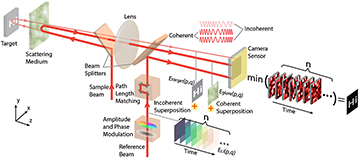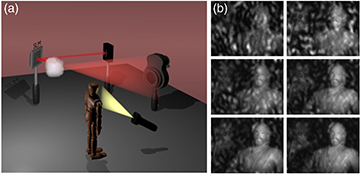Leveraging different optical techniques, two scientific groups—one based in the United States, one in Israel—have proposed approaches to cancel out the glare that can overwhelm the ability to see objects of interest in optically scattering media (Optica, doi: 10.1364/OPTICA.3.001107, 10.1364/OPTICA.3.001104). While neither approach is quite ready to wipe out the glare of your headlights while driving on a foggy road, both could prove quite useful in other contexts, such as biomedical microscopy and astrophysics, that rely on recovering dim images from the glare of scattered light.
A “noise-canceling camera”

In the Caltech team’s setup, light including signal from the target and noise from glare is captured by a camera, along with a reference beam. Cycling through different phase and amplitude values in the reference beam allows destructive interference that wipes out the coherent glare signal, allowing the incoherent light from the target to be recorded. [Image: Zhou et al., Optica, doi: 10.1364/OPTICA.3.001107] [Enlarge image]
Techniques for imaging in scattered media often focus on the media’s tendency to munge the signal—that is, the surrounding medium’s ability, by scattering light, to scramble the waves carrying useful imaging information from the target. But such media create huge amounts of noise as well, in the form of backscattered glare from the surrounding medium itself. It was washing out that glare that the two research teams decided to tackle, using different optical approaches.
One of the teams, led by OSA Fellow Changhuei Yang of the California Institute of Technology, USA, took an approach inspired by acoustic noise cancellation. Dubbed coherence-gated negation (CGN), the scheme involves pointing a sample laser beam at a target within a scattering medium, and routing the returning light—which includes both reflections from the target and backscattered light from the scattering medium—to a camera sensor.
At the same time, a collimated reference beam, passed through optical components that allow its path-length and phase characteristics to be tweaked, is sent to the camera and allowed to interfere with the signal beam. Critically, the light source’s coherence length was selected so that the glare optical field was coherent with respect to the reference field, while the reflected field from the target was incoherent.
In its experimental CGN setup, Yang’s research team found that, by iterating through a range of amplitude and phase values, they could lock onto a set of values that would destructively interfere with the coherent glare field—allowing the incoherent target field to shine through. The researchers reported that they could suppress glare by an order of magnitude using the technique. Edward Haojiang Zhou, the paper’s first author, described the setup as “a kind of noise-canceling camera,” that, like more familiar noise-canceling headphones, separates out the noise and shunts it away from the observer, to allow the target to be easily seen.
An adaptive-optics approach

The Weizmann Institute team experimented by shining a coherent laser light through a scattering medium to create a strong, scattered coherent background field, and used a second, incoherent source to illuminate the target. Using a spatial light modulator, they iteratively shaped the wavefront of the coherent light source to minimize the scattered coherent glare field and allow imaging of the incoherent field from the target. [Image: Daniel et al., Optica, doi: 10.1364/OPTICA.3.001104] [Enlarge image]
The Israeli team, led by OSA Fellow Yaron Silberberg of the Wiezmann Institute of Science, adopted another familiar technique: wavefront shaping, the foundation of adaptive-optics approaches that, in astronomy, have been used by Earth-bound telescopes to pull meaningful images of distant stars from the blur of the atmosphere. Wavefront shaping in scattering media usually employs a spatial light moderator to adjust the spatial phases of the incoming light field, in order to increase the intensity of the part of the light field coming from the target and allow that part to be imaged. Silberberg’s team wondered if the same kind of wavefront shaping could be used to decrease the intensity of the part of the scattered field attributable to glare.
The Israeli group’s tested the concept by using a coherent light source, shone through a random, scattering medium, to create a strong background noise from a scattered coherent field, while simultaneously illuminating a target of interest with incoherent white light. The input coherent field is controlled with a 2-D spatial light modulator, the parameters of which are iteratively adjusted to reduce the power of the scattered speckle field that reaches the camera. As that coherent background noise recedes, the incoherent light from the target image comes into view.
Applications in microscopy and astronomy
While the notion of glare brings to mind the archetypal headlights-on-fog example, neither of the techniques proposed in the Optica papers are likely to find immediate use on that head—in part because, as the Silberberg team writes in its study, such uses “will require extremely fast adaptations, far beyond what is technically feasible today.”
More immediate uses, however, could arise in microbiology, where the Yang team believes its approach could extend the freedom to image through scattering samples of varying thickness, and in astronomy, where the techniques could be used to boost the ability to probe distant stars or to see through the opaque atmosphere of Venus.
“We are trying to develop a toolbox where, using wavefront shaping and SLMs, you can improve imaging, especially under difficult conditions,” Silberberg said in a press release. “Glare reduction will be part of that toolbox.”
